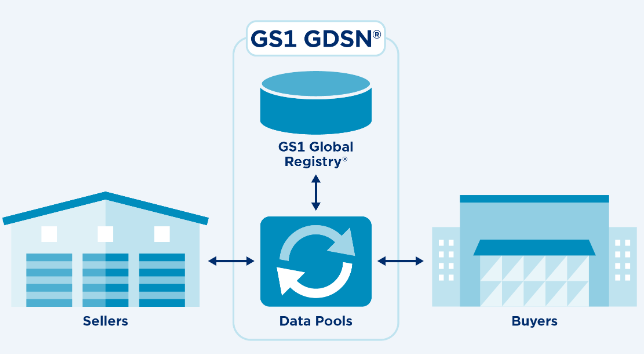How does a manufacturer communicate product information down the Supply Chain? How does a retailer aggregate product information from multiple manufacturers, distributors, and suppliers? These are some of the questions answered by GDSN Product Syndication. An effective Product Information Management (PIM) solution can manage both sides of the GDSN Product Syndication, including sending and receiving the product information.
First, we need to know:
- What is GDSN?
- Why GDSN?
- How does GDSN Work?
What is GDSN?
GDSN (Global Data Synchronization Network) is an internet-based network that enables trading partners to exchange product-identification data in a standardized way in real-time. Launched in 2004, GDSN is an initiative of GS1, a global not-for-profit association that maintains standards for Electronic Data Interchange (EDI), GDSN, barcodes, and RFID (radio frequency identification) tags.
Here’s an illustration from GS1 giving a high-level GDSN architecture:
Technically, GDSN consists of interoperable “data pools” or repositories spread worldwide. Trading partners must choose a data pool to subscribe to. When one supplier updates its product information, all its trading partners receive the product data simultaneously. This means everyone has access to the same continuously refreshed data.
Why GDSN?
GDSN makes it easy and comfortable for sellers and retailers to enrich their product database and access it in real-time for enhanced efficiency. High-quality product information is automatically exchanged, updated, and published through the GDSN network.
The GS1 Global Registry, a central directory that tracks connections between data pools, helps ensure data’s uniqueness and compliance with GS1 standards.
GDSN benefits include:
- Eliminating manual processes
- Reducing errors
- Cutting the time and cost needed to manage and distribute product data
- Increasing trust in product information
- Easing access to product information to end customers in real-time
- Facilitating compliance with health and nutrition standards.
Faster, more convenient access to product information can help bring new products to market more quickly.
How does GDSN Work?
GDSN follows a publish-subscribe messaging model. A unique Global Trade Item Number or GTIN identifies each product or item. The brand owner assigns attributes to the GTIN that provide details about the product along with information like package size and nutrition details.
The brand owner uploads the GTIN to the one data pool it has access to. Each trading partner then uses its own data pool to subscribe to the GTIN. The brand owner authorizes its data pool to publish the GTIN data to the trading partner’s data pool. While GS1 manages the GDSN standard, other vendors implement the standard to synchronize product data through data pools. The most common data pool providers are 1WorldSync (1WS) and Syndigo. These data pools can be a Data Sync Engine (DSE) or Item Management (IM). Here, we’ll focus on 1WS’ Item Management.
Two functional roles are utilized by 1WS Item Management (IM) for batch messaging – Data Source or Data Recipient. The Data Source is typically the seller, such as a manufacturer, wholesaler, distributor, etc. The Data Recipient is the buyer, such as a wholesaler or retailer, or in some cases, a Data Pool. An IM Data Source or Data Recipient can send batch messages to maintain data within IM. In turn, IM returns the corresponding functional response messages to the sending party, indicating the success or error in processing the transaction.
The diagram below provides an end-to-end data flow from 1WorldSync to a 1WS Data Recipient. Note that the 1WorldSync XML messaging is shaded to distinguish it from the standard GDSN messaging.
So, this is how The GDSN data source and recipients will communicate.
FINAL THOUGHTS
Here comes the exciting part! Informatica Product360 includes a GDSN accelerator to configure a data recipient to automate the product data synchronization from GDSN data pools. This provides a single place to consolidate the syndicated and internal product information, including:
- Collect, manage, and enrich your product information
- Create a product master catalog of all product information
- Distribute that product information to your sales and eCommerce channels.
Please review the subsequent article, GDSN Implementation, to learn more about the business value and process of implementing the Informatica Product360 GDSN accelerator.
Contact our Experts at Xpert Data Works for more details or specific questions.


